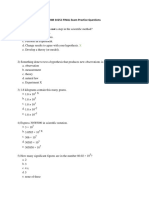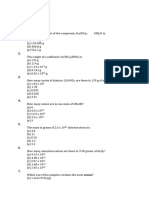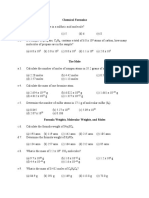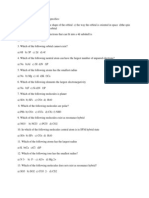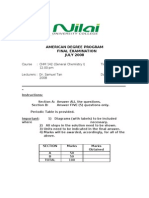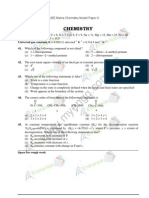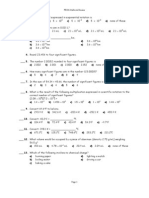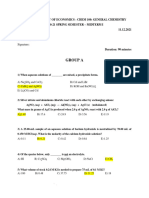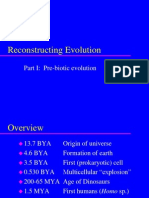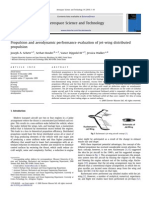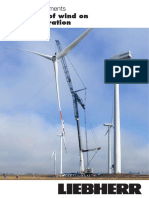Chem Sample Final
Chem Sample Final
Uploaded by
Andres TabaresCopyright:
Available Formats
Chem Sample Final
Chem Sample Final
Uploaded by
Andres TabaresCopyright
Available Formats
Share this document
Did you find this document useful?
Is this content inappropriate?
Copyright:
Available Formats
Chem Sample Final
Chem Sample Final
Uploaded by
Andres TabaresCopyright:
Available Formats
PART I 1. Calculate the average mass of one bromine atom. a) b) c) d) e) 2.654 x 10-22 g 6.022 x 1023 g 1.661 x10-24 g 4.
812 x 10-25 g 1.327 x10-22 g f) 9.624 x 10-22 g g) 1.854 x 10-22 g h) 3.854 x 10-22 g i) 5.647 x 10-22 g j) 6.924 x 10-22 g
GENERAL CHEMISTRY 115 SAMPLE FINAL EXAM
2. How many molecules are contained in 5.00 grams of NH3? a) b) c) d) e) 5.42 x 1022 3.00 x 1024 3.40 x 1022 1.77 x 1023 9.45 x 1022 f) g) h) i) j) 1.79 x 1024 3.54 x 1023 4.10 x 1021 3.38 x 1021 7.08 x 1023
3. Calculate the percent composition of K2CO3. a) b) c) d) e) % K = 58.2% % K = 28.2% % K = 56.6% % K = 39.4% % K = 35.1% % C = 17.9% % O = 23.9% % C = 8.8% % O = 35.9% % C = 8.7% % O = 34.7% % C = 12.0% % O = 48.4% % C = 21.6% % O = 43.2%
4. If a 10.0 g ball of iron at 160.0oC is dropped into 50.0 g of water at 20.0oC in an insulated container, what will be the final temperature of the water? The specific heat of iron is 0.444 J/g oC and that of water is 4.18 J/g oC. a) b) c) d) e) 23oC 38oC 48oC 82oC 110oC f) g) h) 46oC i) j) 33oC 62oC 69oC 93oC
5. Assume that a calcium atom is spherical, and its radius is 1.97 x 10-8 cm. What is the volume of a calcium atom expressed in cubic inches? Volume of a sphere: V = (4/3)r3 and = 3.14. 1 in = 2.54 cm a) b) c) d) e) 5.24 x 10-22 in3 1.95 x 10-24 in3 3.25 x 10-8 in3 68.6 in3 8.16 x 10-12 in3 f) 5.24 in3 g) 2.96 x 10-22 in3 h) 5.49 x 10-22 in3 i) 6.24 x 10-22 in3 j) 8.76 x 10-22 in3
6. The molecular formula for a compound is CX4. If 2.819 g of this compound contains 0.102 g of carbon, what is the atomic weight of X? a) b) c) d) 320 160 39.9 79.9 f) g) h) i) 89.4 35.5 97 45.9
e) 195
j) 125
7. Determine the simplest formula for a hydrocarbon if the complete combustion of a sample produces 3.96 g of CO2 and 2.16 g of H2O. a) b) c) d) e) C2H3 C6H16 CH3 CH C3H6 f) g) h) i) j) C2H2 C2H6 C6H14 C3H8 C2H5
8. A dolomite ore contains 40.0% pure MgCO3 CaCO3. No other compounds of magnesium or calcium are present in the ore. What mass of magnesium and what mass calcium are contained in 100.0 grams of this ore? a) b) c) d) e) 18.3 g Mg - 21.7 g Ca 7.91 g Mg - 13.0 g Ca 8.70 g Mg - 31.3 g Ca 5.27 g Mg - 8.69 g Ca 34.5 g Mg - 5.30 g Ca
9. How many grams of oxygen are required to burn 0.10 mole of C3H8? C3H8 + 5O2 --> 3CO2 + 4H2O a) b) c) d) e) 8.0 g 12 g 16 g 32 g 64 g g) h) i) j) f) 10.0 g 14.0 g 18.0 g 28.0 g 42.0 g
10. If 6.6 g of fluorine reacts with 5.6 g chlorine to produce 8.5 g of chlorine trifluoride, what is the limiting reactant and the percent yield of chlorine trifluoride? Cl2 + 3F2 --> 2ClF3 a) b) c) d) e) F2, 45% Cl2, 58% Cl2, 53% F2, 69% F2, 79% f) g) h) i) j) Cl2, 45% F2, 58% F2, 53% Cl2, 69% Cl2, 79%
11. Ethyl butyrate (C6H12O2), "oil of pineapple", can be produced in the laboratory from butyric acid (C4H8O2), a foul-smelling liquid, and ethyl alcohol (C2H6O). First, butyric acid is reacted with PCl5 to produce butyryl chloride (C4H7ClO) which is then reacted with the ethyl alcohol to produce the ethyl butyrate. What mass of ethyl butyrate could be produced from 12.8 g of butyric acid if the first reaction gave a 65.8% yield of butyryl chloride and the second reaction gave a 88.4% yield of ethyl butyrate? The equations below are balanced. C4H8O2 + PCl5 --> C4H7ClO + HCl + POCl3 C4H7ClO + C2H6O --> C6H12O2 + HCl
a) 8.80 g f) 9.25 g b) 9.01 g g) 4.87 g c) 8.47 g h) 7.39 g d) 16.9 g i) 6.80 g e) 9.81 g j) 5.30 g 12. What is the molarity of 175 mL of solution containing 2.18 grams of Na2SO4 10H2O? a) b) c) d) e) 3.77 x 10-3 M 6.44 x 10-1 M 8.78 x 10-3 M 1.18 x 10-3 M 3.87 x 10-2 M f) 3.77 x 10-4 M g) 2.43 x 10-1 M h) 5.67 x 10-3 M i) 2.79 x 10-3 M j) 4.57 x 10-3 M
13. The specific gravity of commercial nitric acid solution is 1.42 (i.e. 1.42 g/cc) and it is 70.0% HNO3 by mass. Calculate its molarity. a) b) c) d) e) 18.0 M 15.8 M 12.8 M 99.4 M 26.2 M f) 12.0 M g) 88.0 M h) 14.2 M i) 8.0 M j) 5.0 M
14. What mass of calcium carbonate, CaCO3, is required to react with 100 mL of 2.00 M HCl solution? CaCO3 + 2HCl --> CaCl2 + CO2 + H2O a) b) c) d) e) 5.00 g 10.0 g 15.0 g 20.0 g 23.0 g f) g) h) i) j) 25.00 g 35.00 g 52.00 g 28.00 g 12.00 g
PART II 15. Which one of the following salts is soluble in water? a) b) c) d) e) BaSO4 Ag2CO3 FeS CrPO3 Hg2Cl2 f) g) h) i) j) Hg CO3b) PbSO4 Ba3(PO3)2 AgCl NH4F
16. Which one of the following salts is insoluble in water? a) b) c) d) e) Rb2SO4 (NH4) 2S KI Cr(NO3) 3 Ni(CO3)2 f) Li2SO4 g) PbCrO4 h) RbOH i) NaI j) Cs2SO4
17. The oxidizing agent is ______, and it is ______ in the following reaction.
2MnO4- (aq) + 3S2- (aq) + 4H2O(l) --> 2MnO2 (s) + 3S(s) + 8OH- (aq) a) b) c) d) MnO4-, oxidized S2-, oxidized MnO4-, reduced H2O, reduced e) S2-, reduced f) H2O, reduced g) none of the above answers
18. Which one of the following is a weak electrolyte? a) b) c) d) KBr H2SO4 H2CO3 NH4ClO
40
e) Ca(OH)2 f) KOH g) none of the above answers Ar isotope. An atom of this isotope contains _____ neutrons.
19. Consider the a) b) c) d) e)
18 22 32 40 none of these
20. Naturally occurring lithium exists as two isotopes, 6Li (mass = 6.0151 amu) and 7Li (mass = 7.0160 amu). The atomic weight of lithium is 6.941 amu). What is the percent abundance of 7Li? a) b) c) d) 4.3 % 7.8 % 95.7 % 92.5 % e) 7.5 % f) 1.8 % g) 89.2 %
Some of the following values may be useful for solving some of the following problems. speed of light = 3.00 x 108 m/s: 1 joule = 1 kg
34
.m /s :
2 2
Planck's constant = 6.63 x 10-
J s 21. What is the energy, in J/photon, of blue light having a wavelength of 4.240 x 10-7 m? a) b) c) d) 5.00 x 10-13 m 4.69 x 10-19 m 3.18 x 10-13 m 9.92 x 10-4m e) f) g) h) 3.18 x 10-16 m 3.14 x 1012 m 3.14 x 10-12 m 5.00 x 10-3 m
22. What is the de Broglie wavelength of a proton of mass 1.67 x 10-24 g moving at a velocity of 1.25 x 106 m/s? a) b) c) d) 5.00 x 10-1 m 3.14 x 1012 m 3.18 x 10-16 m 9.92 x 10-4m e) f) g) h) 3.18 x 10-13 m 4.69 x 10-19 m 3.14 x 10-12 m 5.00 x 10-13 m
23. Which one of the following electron configurations is incorrect?
a) b) c) d) e)
F 12Mg 17Cl 6C 19K
9
1s22s22p5 [Ne]3s2 [Ne]3s23p5 [He]2s22p4 1s22s22p63s63p64s1
24. What is the electron configuration of oxygen, O2 ? a) b) c) d) e) 1s || || || || || 2s || | || || 2p | || || || || | | || || | | . | . || . |. |.
25. Which element has the highest first ionization energy? a) b) c) d) B Al Ga Cs e) f) g) h) In Tl Na C
26. Arrange the following elements in order of decreasing first ionization energy. Be, Ca, Cs, Mg, K a) b) c) d) Mg > Be > Ca > K > Cs Be > Mg > Ca > K > Cs Be > K > Ca > Cs > Mg Ca > Mg > Be > Cs > K e) f) g) h) Ca > Mg > Be > K > Cs Cs > K > Ca > Be > Mg Be > Ca > Be > K > Cs Be > Ca > Mg > K > Cs
27. Which one of the following pairs contains isoelectronic species? a) b) c) d) e) Na, Na+ S, Se S2-, Se2F2 , Cl2 Na+, O2-
28. Which ion has the largest radius? a) b) c) d) e) Li+ Na+ Be2+ Mg2+ Al3+
29. What is the formula for the binary compound of aluminum and nitrogen? a) b) c) d) e) Al2N2 Al2N AlN2 Al2N3 AlN
30. Which one of the formulas below is incorrect? a) b) c) d) e) SrCl2 Cs2S AlCl3 Al3P2 CaSe
31. Draw the correct Lewis dot formula for H2CO3 ?
32. How many lone pairs of electrons are there on the Xe atom in the XeF4 molecule? a) b) c) d) e) one two three four zero
33. The elements of Group VIIA may react with each other to form covalent compounds. Which of the following single covalent bonds in such compounds is the most polar bond? The electronegativities of the first four Group VIIA elements are: F = 4.0, Cl = 3.0, Br = 2.8, I = 2.5 a) b) c) d) e) F-F F-Cl F-Br F-I Cl-I
34. Which species is incorrectly matched with the hybridization at the central atom? Compound a) b) c) d) e) BF3 SnCl4 AsF5 H2O BeCl2 Hybridization at Central Atom sp2 sp3 sp3d2 sp3 sp
35. Which, if any, of the compounds listed are not sp3 hybridized at the central atom? I. CF4 II. H2 O III. SiF4 IV. CHCl3 V. NH3 a) III and IV b) I, II, and III
c) II, IV, and V d) III and V e) all are sp3 hybridized 36. Which response contains all the characteristics listed that should apply to phosphorus trichloride, PCl3, and no other characteristics? I. trigonal planar II. polar bonds III. sp3 hybridized at P IV. polar molecule V. one unshared pair of electrons on P a) b) c) d) e) I, IV, and V II, III, and IV I, II, and IV II, IV, and V none of the above answers
37. Many simple molecules contain lone pairs of electrons (also referred to as unshared pairs) which occupy hybrid orbitals of the central element in a molecule. If an atom of the central element utilizes sp3 hybrid orbitals in a compound, which one of the following types of repulsions would be greater? a) b) c) d) e) bonding pair-bonding pair bonding pair-lone pair lone pair-bonding pair lone pair-lone pair repulsions between all types of pairs of electrons are the same
38. Which one of the following species could not react as a Bronsted-Lowry base? a) NH4+ b) NH2c) CNd) Fe) CH3COO39. Which cannot be both a Bronsted-Lowry acid and a Bronsted-Lowry base? a) H2O b) HCO3c) H2PO4d) HPO42e) PO4340. What is the molarity of a barium hydroxide solution if 18.62 mL of this Ba(OH)2 solution requires 35.84 mL of 0.2419 M HCl for titration to the equivalence point? a) b) c) d) 0.4656 M 0.2328 M 0.1164 M 0.3492 M e) f) g) h) 0.1164 M 0.1746 M 0.5238 M 0.6984 M
41. Consider the complete neutralization reactions between the following acid-base
pairs in dilute aqueous solutions. In which of these have strong acids listed as reactants? I. CH3COOH + NaOH --> III. H3PO4 + Ca(OH)2 --> V. H2CO3 + Sr(OH)2 --> a) b) c) d) e) I and V II and IV II, III, and IV II, III, and V III, IV, and V II. HNO3 + Mg(OH)2 --> IV. HCl + KOH -->
42. Balance the following net ionic equation. What is the coefficient of S? a) b) c) d) e) H2S + 1 2 3 4 none of these NO3+ H+ ---> S + NO + H2O
43. What volume of 0.100 M (COOH)2 solution would be required to react with 0.164 grams of KMnO4? 5(COOH)2 + a) b) c) d) 31.9 mL 51.8 mL 77.8 mL 104 mL 2MnO4- + e) f) g) h) 28.6 mL 35.4 mL 25.9 mL 90.8 mL 6H+ ---> 10CO2 + 2Mn2+ + 8H2O
44. What is the oxidation number of tin in the HSnO3- ion ? a) b) c) d) e) +1 +2 +3 +4 +5
45. If 5.50 L of argon gas at 273oC is heated at constant pressure to a temperature of 546oC, what would be its new volume? R = 0.0821 L atm/deg mol a) b) c) d) 11.0 L 16.5 L 2.75 L 3.67 L e) 33.0 L f) 10.25 L g) 18.25 L h) 8.25 L
46. A sample of nitrogen occupies a volume of 546 mL at STP. What volume would the nitrogen occupy at 177oC under a pressure of 380. torr? a) b) c) d) 91 mL 273 mL 900. mL 1.09 x 103mL e) 1.80 x 103 mL f) 180 mL g) 1.30 x 103 mL h) 2.60 x 103 mL
47. What is the molecular weight of a gas if 5.00 grams of it occupies 2200. mL at STP? a) b) c) d) 50.9 g/mol 42.6 g/mol 59.6 g/mol 63.4 g/mol e) f) g) h) 69.9 g/mol 67.0 g/mol 53.1 g/mol 68.0 g/mol
49. What is the pressure of 64.0 g of oxygen gas in a 1.50-L container at -37oC? a) b) c) d) 4.12 atm 25.8 atm 51.6 atm 19.6 atm e) f) g) h) 9.2 atm 73.6 atm 54.2 atm 8.2 atm
50. Calculate the density of O2 gas (in g/L) at 1.22 atm and 25oC. a) b) c) d) 1.74 g/L 1.60 g/L 0.871 g/L 19.0 g/L e) f) g) h) 0.698 g/L 1. 43g/L 2.758 g/L 0.888 g/L
51. Which one of the following melts at the lowest temperature at a given pressure? a) b) c) d) e) CH4 LiCl C10H8 CaCl2 H2O
52. Which one of the following is a covalent network solid? a) b) c) d) e) sulfur trioxide nickel ammonium chloride silicon carbide, SiC sucrose, C12H22O11
53. Which response includes all of the following compounds that exhibit hydrogen bonding and no other compounds? CH4, AsH3, CH3NH2, H2Te, HF a) b) c) d) e) AsH3, H2Te CH3NH2, HF CH4, AsH3, H2Te AsH3, CH3NH2 HF, H2Te
54. Which of these aqueous solutions would be expected to have the highest boiling point? a) 0.100 m CaCl2 b) 0.200 m NaOH
c) 0.050 m K2SO4 d) 0.050 m Al2 (SO4)3 e) 0.200 m CH3OH 55. When 27.0 g of an unknown nonelectrolyte is dissolved in 250.0 mL of benzene, the solution boils at 82.5oC. Calculate the molecular weight of the unknown nonelectrolyte. The Kb for benzene = 2.53oC/m. The boiling point of pure benzene is 80.1oC. The density of benzene = 0.876 g/mL. a) b) c) d) 60 g/mol 110 g/mol 120 g/mol 150 g/mol e) f) g) h) 115 g/mol 140 g/mol 130 g/mol 220 g/mol
56. What is the mole fraction of methanol, CH3OH, in an aqueous solution that is 20.0% methanol by mass? a) b) c) d) 0.250 0.544 0.101 0.123 e) f) g) h) 0.350 0.550 0.280 0.308
57. A sketch of the phase diagram (not to scale) of water is given below. Which statement is false? a) Line AD is the sublimation curve - solid and vapor are in equilibrium. b) Point A is the triple point - solid, liquid, and vapor are at equilibrium. c) Line AC is the vapor pressure curve - liquid and gas (vapor) are in equilibrium. d) Line AB is the melting curve - solid and liquid are in equilibrium. e) The slope of line AB is negative showing that as the liquid is cooled, the molecules get closer and closer together as they solidify.
You might also like
- CHM 1025c Final Exam Practice WCDocument5 pagesCHM 1025c Final Exam Practice WCMiguel SuarezNo ratings yet
- 3 - Molecules and Compounds: Practice TestDocument2 pages3 - Molecules and Compounds: Practice Testfamily_jvcNo ratings yet
- Test 1Document3 pagesTest 1vbqvbqNo ratings yet
- XCXZCDocument3 pagesXCXZCFahimuddin QureshiNo ratings yet
- Chemistry 151 Final Exam Review QuestionsDocument12 pagesChemistry 151 Final Exam Review Questionsmiketol100% (1)
- AP Chemistry Unit 1 Practice - QuizizzDocument6 pagesAP Chemistry Unit 1 Practice - Quizizzzubaida alaniNo ratings yet
- Chemistry Question Banks AyDocument67 pagesChemistry Question Banks AyOni AyomideNo ratings yet
- Basic Organic Chemistry+Anions Cations+Moles+ HydrocarbonsDocument6 pagesBasic Organic Chemistry+Anions Cations+Moles+ HydrocarbonsPrakash KapadiaNo ratings yet
- CHE1501 Practice?imbuzi?Document29 pagesCHE1501 Practice?imbuzi?hethersmith0No ratings yet
- CHEM 1411 - General Chemistry I Practice Problems, Chapters 1-3Document8 pagesCHEM 1411 - General Chemistry I Practice Problems, Chapters 1-3Lheidyy36No ratings yet
- CHEM 1307 Exam 1 Practice Problems: C CL P K NDocument5 pagesCHEM 1307 Exam 1 Practice Problems: C CL P K NPayal PawarNo ratings yet
- 1045 Practice Exam 1Document7 pages1045 Practice Exam 1Jules BrunoNo ratings yet
- CHEM101 172 Final SolvedDocument12 pagesCHEM101 172 Final SolvedTorong VNo ratings yet
- Ch. 1,2,3,4Document29 pagesCh. 1,2,3,4Kankana ChoudhuryNo ratings yet
- Midterm Preparation DocumentDocument15 pagesMidterm Preparation DocumentbettieboomNo ratings yet
- Quice Review Center: C) The Total Mass of The Atom A) RBDocument5 pagesQuice Review Center: C) The Total Mass of The Atom A) RBMary Francia RicoNo ratings yet
- Exam 3 ChemistryDocument9 pagesExam 3 ChemistryEvelynNo ratings yet
- Summative Exams For General and Analytical ChemistryFOR STUDENTDocument5 pagesSummative Exams For General and Analytical ChemistryFOR STUDENTsantos earlNo ratings yet
- VITEEE Chemistry 2014Document8 pagesVITEEE Chemistry 2014SachinNo ratings yet
- ChemistryDocument40 pagesChemistryts8166100% (3)
- Chemy 101 1st 19-20 Test 1 Key CDocument8 pagesChemy 101 1st 19-20 Test 1 Key CmNo ratings yet
- Some Basic Concepts of Chemistry FinalDocument4 pagesSome Basic Concepts of Chemistry FinalalgostockstradingNo ratings yet
- Stoichiometry 1Document4 pagesStoichiometry 1hey mama don’t stress your mindNo ratings yet
- CHEM1110 - Final Exam, Practice #1Document7 pagesCHEM1110 - Final Exam, Practice #1hüseyin özçınarNo ratings yet
- Chapter 03Document53 pagesChapter 03Sigmund PohanNo ratings yet
- Ntu 2008 ChemDocument6 pagesNtu 2008 ChemAgitya Putra KusumaNo ratings yet
- Chemistry Structure and Properties 1st Edition Tro Test Bank 1Document53 pagesChemistry Structure and Properties 1st Edition Tro Test Bank 1thomas100% (53)
- Chemistry Practise QuestionDocument12 pagesChemistry Practise Questiong24n3950No ratings yet
- 1411 Exam 1 Practice 151Document5 pages1411 Exam 1 Practice 151garciajeremiah070No ratings yet
- 400 Test ChemDocument36 pages400 Test ChemshmlnizNo ratings yet
- Review For Test 2 ch3 and ch4Document5 pagesReview For Test 2 ch3 and ch4Alison VelázquezNo ratings yet
- Chem ProblemsDocument82 pagesChem ProblemsBeverly RamosNo ratings yet
- CHM142 Final July 2008Document11 pagesCHM142 Final July 2008Lee_Moi_Yeoh_6863No ratings yet
- Exam 4 FS10 0800-2Document5 pagesExam 4 FS10 0800-2Yu HuiNo ratings yet
- WWW Myengg Com JEE Main Chemistry Model Paper 6Document8 pagesWWW Myengg Com JEE Main Chemistry Model Paper 6Senthil PNo ratings yet
- Chemistry Test t1 Q Neet Test 5Document16 pagesChemistry Test t1 Q Neet Test 5SahanaaNo ratings yet
- 1411 Practice Exam 3 Brown 9-12Document5 pages1411 Practice Exam 3 Brown 9-12garciajeremiah070No ratings yet
- 101 Tutorial Chang Student VersionDocument48 pages101 Tutorial Chang Student Versionhsddwkvs7hNo ratings yet
- Practice Exam 2Document9 pagesPractice Exam 2N193746No ratings yet
- CHEM 101 Test1 - Marking KeyDocument15 pagesCHEM 101 Test1 - Marking KeylentlebuisanyangNo ratings yet
- New Microsoft Word DocumentDocument2 pagesNew Microsoft Word DocumentUday Prakash SahuNo ratings yet
- Review for Chapter( 6,7,8,16 )Document5 pagesReview for Chapter( 6,7,8,16 )cmkr65nf2tNo ratings yet
- Chemy 101 1st 19-20 Test 1 Key BDocument7 pagesChemy 101 1st 19-20 Test 1 Key BmNo ratings yet
- Icho 15Document28 pagesIcho 15los sabiosNo ratings yet
- Diagnostic ExamDocument12 pagesDiagnostic ExamAnabel AbulenciaNo ratings yet
- Review Midterm1Document6 pagesReview Midterm1jagloopipiNo ratings yet
- Chapter 1 3 Class Xi MCQDocument11 pagesChapter 1 3 Class Xi MCQZaid KhanNo ratings yet
- Test 6Document11 pagesTest 6Prakash KapadiaNo ratings yet
- CHM11-3 ReviewerDocument23 pagesCHM11-3 ReviewerPaolo Gochingco100% (3)
- NEET 11 - Full TestDocument93 pagesNEET 11 - Full Testrs3369792No ratings yet
- NMAT Review Take Home ExamDocument15 pagesNMAT Review Take Home ExamRafael SaldivarNo ratings yet
- Chemistry Term 1 MCQ 2021Document29 pagesChemistry Term 1 MCQ 2021manish dagarNo ratings yet
- Test 7Document4 pagesTest 7Prakash KapadiaNo ratings yet
- Chem100 Midterm2021Document7 pagesChem100 Midterm2021atomtostNo ratings yet
- 01 Pract TestDocument6 pages01 Pract TestJinn Allan LuañaNo ratings yet
- Neet Assignment PDFDocument9 pagesNeet Assignment PDFzpwzfz2rypNo ratings yet
- Chemistry MCQDocument26 pagesChemistry MCQArun Sharma0% (1)
- NEET National Eligibility Cum Entrance Test Chemistry Class 11 + 12 Volume I + Volume IIFrom EverandNEET National Eligibility Cum Entrance Test Chemistry Class 11 + 12 Volume I + Volume IINo ratings yet
- Graphene Oxide: Fundamentals and ApplicationsFrom EverandGraphene Oxide: Fundamentals and ApplicationsAyrat M. DimievNo ratings yet
- Marfan Syndrome: Disorder Gene Protein/Abnormal Chrom. Comment/classic FindingsDocument71 pagesMarfan Syndrome: Disorder Gene Protein/Abnormal Chrom. Comment/classic FindingsAndres TabaresNo ratings yet
- Treatment of Alcohol AbuseDocument3 pagesTreatment of Alcohol AbuseAndres TabaresNo ratings yet
- Block 1: Neuroanatomy Score Total Lecture Exam 51 65 Lab Practical 66.5 75 Lab Quiz Questions 5 5Document1 pageBlock 1: Neuroanatomy Score Total Lecture Exam 51 65 Lab Practical 66.5 75 Lab Quiz Questions 5 5Andres TabaresNo ratings yet
- Conducting A Pelvic Exam 1-24-17Document36 pagesConducting A Pelvic Exam 1-24-17Andres TabaresNo ratings yet
- Thyroid LectureDocument65 pagesThyroid LectureAndres TabaresNo ratings yet
- Diabetes Mellitus Types 1 & 2: Jessica Perini, MD Sect. Endocrinology WVU Dept of Internal Medicine March 14, 2017Document111 pagesDiabetes Mellitus Types 1 & 2: Jessica Perini, MD Sect. Endocrinology WVU Dept of Internal Medicine March 14, 2017Andres TabaresNo ratings yet
- Ethics Lecture 1 2016 Autonomy PreDocument99 pagesEthics Lecture 1 2016 Autonomy PreAndres TabaresNo ratings yet
- Case Studies SummariesDocument40 pagesCase Studies SummariesAndres TabaresNo ratings yet
- Nephron MapDocument1 pageNephron MapJessica MooreNo ratings yet
- Lecture 4 - MuscleDocument64 pagesLecture 4 - MuscleAndres TabaresNo ratings yet
- Reconstructing Evolution: Part I: Pre-Biotic EvolutionDocument32 pagesReconstructing Evolution: Part I: Pre-Biotic EvolutionAndres TabaresNo ratings yet
- Week 10 Architectectural EngineeringDocument30 pagesWeek 10 Architectectural EngineeringRahim AssaniNo ratings yet
- Intelligent BuildingDocument15 pagesIntelligent Buildingkriti_328No ratings yet
- 00 Cameron Gate Valve IntroductionDocument14 pages00 Cameron Gate Valve IntroductionsubodhasinghNo ratings yet
- Lesson Learned Esperienza Di Attivazione PMODocument24 pagesLesson Learned Esperienza Di Attivazione PMOgispa87No ratings yet
- Valve and Actuator: An IntroductionDocument19 pagesValve and Actuator: An IntroductionZakky Ibnu FadjrieNo ratings yet
- Tropical Design TheoriesDocument2 pagesTropical Design TheoriesN/A80% (5)
- FMEA TemplateDocument28 pagesFMEA TemplatehiryanizamNo ratings yet
- Aerospace Science and Technology: Joseph A. Schetz, Serhat Hosder, Vance Dippold III, Jessica WalkerDocument10 pagesAerospace Science and Technology: Joseph A. Schetz, Serhat Hosder, Vance Dippold III, Jessica WalkerEsteban ValenciaNo ratings yet
- Anshul Final UltraDocument3 pagesAnshul Final UltraAvinash SinghNo ratings yet
- 2020 Time Delay Catalog 05 18 20Document52 pages2020 Time Delay Catalog 05 18 20Manuel Guardia AraujoNo ratings yet
- Roving Frame: Spinning 1STDocument32 pagesRoving Frame: Spinning 1STfekadeNo ratings yet
- CV KasongoDocument14 pagesCV KasongoDickson MatikuNo ratings yet
- JD-QA EngineerDocument1 pageJD-QA EngineerSAMPATHUNo ratings yet
- Part Number 27-58: Installation, Operation, and Maintenance With Illustrated Parts BreakdownDocument26 pagesPart Number 27-58: Installation, Operation, and Maintenance With Illustrated Parts BreakdownLuis Eduardo Albarracin RugelesNo ratings yet
- Performance Testing Air Conditioning EquipmentDocument14 pagesPerformance Testing Air Conditioning EquipmentLone CruzenaNo ratings yet
- Laser Ignition For Internal Combustion EnginesDocument23 pagesLaser Ignition For Internal Combustion EnginesSUMANTH n vNo ratings yet
- 2020 - 11 - 12 Alcad Slim Battery Solution LaunchDocument2 pages2020 - 11 - 12 Alcad Slim Battery Solution LaunchabdelhalimNo ratings yet
- Pre-Analysis: Example: Steady One-Dimensional Heat Conduction in A BarDocument12 pagesPre-Analysis: Example: Steady One-Dimensional Heat Conduction in A BarRiyaz RiyazNo ratings yet
- Kprime Tooth System - BrochureDocument10 pagesKprime Tooth System - BrochuremvcspncoagpNo ratings yet
- Mukesh ResumeDocument3 pagesMukesh ResumeMukesh Kumar PrajapatiNo ratings yet
- Kabya DetailDocument9 pagesKabya DetailAnup MishraNo ratings yet
- Part-2-July21 A P P E N D I X 1 1 Qualification For Welders and Welding OperatorsDocument24 pagesPart-2-July21 A P P E N D I X 1 1 Qualification For Welders and Welding OperatorsSergio AlejandroNo ratings yet
- Liebherr: Influence of Wind On Crane Operation 2017Document56 pagesLiebherr: Influence of Wind On Crane Operation 2017Mohamad ArrajNo ratings yet
- Safety Data Sheet: Section 1. IdentificationDocument13 pagesSafety Data Sheet: Section 1. Identificationrahulsaini855No ratings yet
- Confirm Delegate List - Final (4th July)Document38 pagesConfirm Delegate List - Final (4th July)Abirami PriyadharsiniNo ratings yet
- T1ducttype PDFDocument36 pagesT1ducttype PDFDung Vo TanNo ratings yet
- Plastic Design Methods - Advantages and LimitationsDocument25 pagesPlastic Design Methods - Advantages and Limitations75bm73No ratings yet
- AC4 - AC5 Horizntal Series ManualDocument8 pagesAC4 - AC5 Horizntal Series ManualDaniel RibeiroNo ratings yet
- Error CodesDocument76 pagesError CodesVenkatesh Ravipati0% (2)
- API-571 Mockup Test-01-QuestionsDocument13 pagesAPI-571 Mockup Test-01-QuestionsMonday100% (1)
